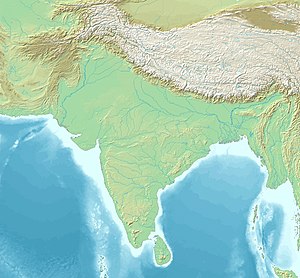
In Buddhism, Buddha, "awakened one", is a title for those who are awake, and have attained nirvana and Buddhahood through their own efforts and insight, without a teacher to point out the dharma. The title is most commonly used for Gautama Buddha, the founder of Buddhism, who is often simply known as "the Buddha". Buddhahood is the condition and rank of a buddha "awakened one". This highest spiritual state of being is also termed Samyaksaṃbodhi.

Lumbinī is a Buddhist pilgrimage site in the Rupandehi District of Lumbini Province in Nepal. It is the place where, according to Buddhist tradition, Queen Mahamayadevi gave birth to Siddhartha Gautama at around 563 BCE. Gautama, who achieved Enlightenment some time around 528 BCE, became the Buddha and founded Buddhism. Lumbini is one of many magnets for pilgrimage that sprang up in places pivotal to the life of the Buddha.
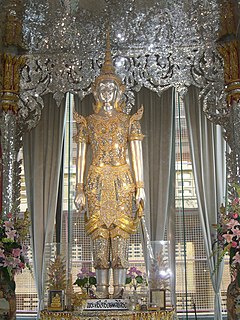
Maitreya (Sanskrit) or Metteyya (Pali) is regarded as a future Buddha of this world in Buddhist eschatology. In some Buddhist literature, such as the Amitabha Sutra and the Lotus Sutra, the being is referred to as Ajita.

Tathāgata is a Pali word; Gautama Buddha uses it when referring to himself or other Buddhas in the Pāli Canon. The term is often thought to mean either "one who has thus gone" (tathā-gata), "one who has thus come" (tathā-āgata), or sometimes "one who has thus not gone" (tathā-agata). This is interpreted as signifying that the Tathāgata is beyond all coming and going – beyond all transitory phenomena. There are, however, other interpretations and the precise original meaning of the word is not certain.
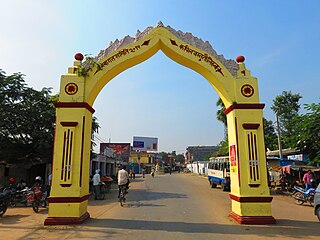
Kapilvastu is a municipality and administrative center of Kapilvastu District in Lumbini Pradesh of southern Nepal. The municipality is located roughly 25 kilometres (16 mi) to the south-west of Lumbini, a UNESCO World Heritage Site and the birthplace of Gautama Buddha.

Kakusandha Buddha (Pāli), known as Krakucchaṃda in Sanskrit, is one of the ancient Buddhas whose biography is chronicled in chapter 22 of the Buddhavamsa, one of the books of the Pāli Canon.

Butwal, officially Butwal Sub-Metropolitan City, is one of the twin cities of rapidly growing Butwal-Bhairahawa urban agglomeration in Nepal. The city lies in Rupandehi District on Lumbini Province and also served as the interim capital of the province for nearly 3 years, until 2020 when Deukhuri was formally voted as the capital. It was given the title "Green City of Nepal 2019". It was also home to the administrative headquarters of Lumbini Zone. This city stands beside the bank of Tinau River, and at the northern edge of the Terai plain below the Siwalik Hills. Its name, Butwal was derived from Batauli Bazaar, the town's oldest residential area which is located on the western bank of the Tinau river. Butwal is a lively city comprising the Panoramic views of the combination of hills and plains.

Kassapa Buddha (Pāli), known as Kāśyapa in Sanskrit, is one of the ancient Buddhas whose biography is chronicled in chapter 24 of the Buddhavamsa, one of the books of the Pāli Canon.

The Buddhavaṃsa is a hagiographical Buddhist text which describes the life of Gautama Buddha and of the twenty-four Buddhas who preceded him and prophesied his attainment of Buddhahood. It is the fourteenth book of the Khuddaka Nikāya, which in turn is the fifth and last division of the Sutta Piṭaka. The Sutta Piṭaka is one of three pitakas which together constitute the Tripiṭaka, or Pāli Canon of Theravāda Buddhism.

Bode is an ancient Newar city in the east corner of the Kathmandu Valley, Nepal, about eight miles from the capital city, Kathmandu.The city is famous for Biska Jatra and tongue piercing and Nilbharahi Naach. At the time of the 2011 Nepal census it had a population of 6,364 with 1,389 houses.

Tilaurakot is a neighborhood in Kapilvastu Municipality in Kapilvastu District, in the Lumbini Province of southern Nepal. Previously it was a Village development committee. At the time of the 1991 Nepal census it had a population of 5684 people living in 944 individual households. It is situated 25 kilometers (15.5 mi) northwest of the Maya Devi Temple in Lumbini, and 4.5 kilometers (2.8 mi) southeast of Nigali Sagar in Nigalihawa.
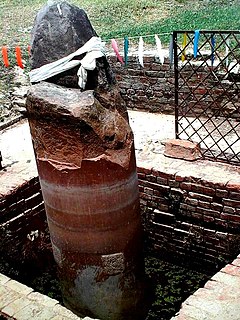
Gotihawa is a village development committee located about 4 kilometres (2.5 mi) southeast of Kapilavastu, in Kapilvastu District, in the Lumbini Zone of southern Nepal. At the time of the 1991 Nepal census it had a population of 3335 people living in 567 individual households.

Koṇāgamana Buddha (Pāli), known as Kanakamuni in Sanskrit, also known as Koṇāgon or Kanakagamana, is one of the ancient Buddhas whose biography is chronicled in chapter 23 of the Buddhavamsa, one of the books of the Pāli Canon.
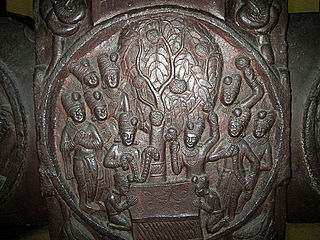
In Buddhist tradition, Vipassī (Pāli) is the twenty-second of twenty-eight Buddhas described in Chapter 27 of the Buddhavamsa. The Buddhavamsa is a Buddhist text which describes the life of Gautama Buddha and the twenty-seven Buddhas who preceded him. It is the fourteenth book of the Khuddaka Nikāya, which in turn is part of the Sutta Piṭaka. The Sutta Piṭaka is one of three pitakas which together constitute the Tripiṭaka, or Pāli Canon of Theravada Buddhism.
According to the Buddhavamsa and Buddhist mythology, Sikhī (Pāli) is the twenty-third of twenty-eight Buddhas. The penultimate Buddha of the Alamkarakalpa, Sikhī was preceded by Vipassī Buddha and succeeded by Vessabhū Buddha.
According to Theravada Buddhism's Pali canon's Buddhavamsa and its commentary, Sumedha Buddha is the fourteenth of twenty-seven Buddhas who preceded the historical Gotama Buddha. Sumedha Buddha was born in Sudassana. According to the canon at the age of 9,000 years old he became an ascetic, practiced austerities for fifteen days, and attained Enlightenment. He lived 90,000 years, and died in Medhārāma.
Vaṃsa, alternatively spelled as Vamsa or Vamsha, is a Sanskrit word that means "family, lineage". It also refers to a genre of ancient and medieval literature in Buddhism, Hinduism and Jainism. This genre focuses on genealogies. They resemble the conventional histories found in the European literature, but differ as they predominantly chronicle myths and may integrate spiritual doctrines such as rebirths. A vamsa can be focussed on a dynasty, family, individual such as a saint, line of teachers of a particular tradition, or a place particularly of pilgrimage. Some of these texts are titled with vamsa as a suffix.
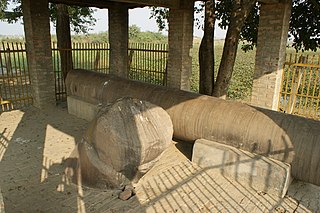
Nigali Sagar is an archaeological site in Nepal containing the remains of a pillar of Ashoka. The site is located in Nigalihawa, about 20 kilometers northwest of Lumbini and 7 kilometers northeast of Taulihawa. Another famous inscription discovered nearby in a similar context is the Lumbini pillar inscription.
Maṅgala Buddha is the sixth of twenty-seven Buddhas who preceded the historical Gotama Buddha according to the Buddhavamsa, a text from the Theravada Pali canon, and its commentary. He was also the first Buddha of the Sāramaṇḍa kalpa.

